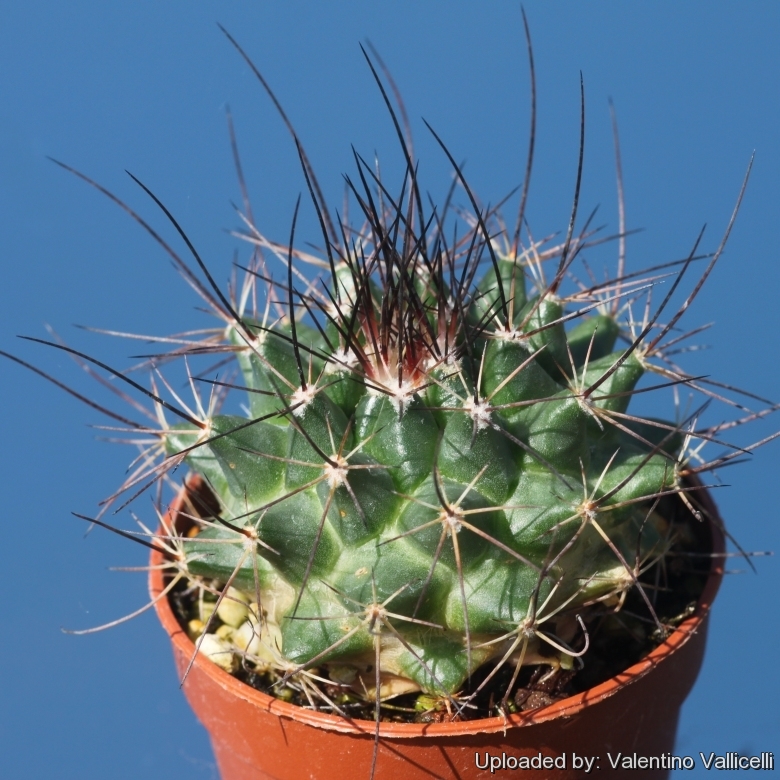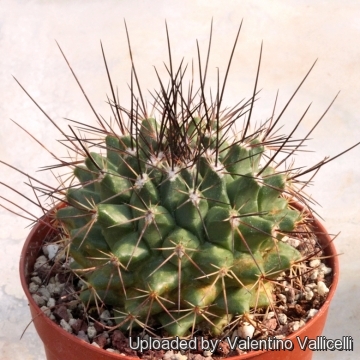= Mammillaria papasquiarensis (Bravo) Repp.
Gattung Mammill. nach dem Heutigen Stand Meines Wissens 1988 137 (1989), basionym without type Repp.
Accepted Scientific Name: Mammillaria grusonii C.Runge
Gartenflora xxxviii. (1889) 105. fig. 20. ( "grusoni" )

Mammillaria tesopacensis var. papasquiarensis (Mammillaria papasquiarensis) Photo by: Valentino Vallicelli
L1073 (Collector Alfred Bernhard Lau) Penon Blanco, South of Nazas, Durango, Mexico Altitude: 1800 m a.s.l. (a.ka. M. wagneriana)
Origin and Habitat: Mammillaria papasquiarensisSN|15848]]SN|15978]] is endemic to Mexico, where it can be found in the states of Durango (Santiago Papasquiaro, Guatimape, Laguna Morcillo, La Concha, Nazas, Cerro Blanco, San Juan del Rio)
Altitude range: 1700-2200 metres above sea level.
Habitat and ecology: This species grows on low hills together with Echinocereus pectinatusSN|8503]]SN|8503]], Mammillaria chionocephalaSN|15978]]SN|15848]], Opuntia robusta, Opuntia violaceaSN|25092]]SN|25092]], Opuntia herrfeldtii, Agave americanaSN|162]]SN|162]], Yucca filifera, and Dasylirion sp.
Synonyms:
See all synonyms of Mammillaria grusonii
back
Accepted name in llifle Database:Mammillaria grusonii C.RungeGartenflora xxxviii. (1889) 105. fig. 20. ( "grusoni" )Synonymy: 8
back
Description: Mammillaria papasquiarensisSN|15974]]SN|15978]] (firstly described as Mammillaria tesopacensisSN|15978]]SN|15982]] v. papasquiarensis by Bravo & Alt. in 1992 ) is a local or morphological form of the widespread and variable Mammillaria grusoniiSN|15974]]SN|15974]]. It has generally longer spines than the Mammillaria grusoniiSN|15974]]SN|15974]].
Stem: Handsome, large, solitary to about 25 cm in diameter (or more), flat-globular if grown in plenty of sunshine, which it relishes, and which helps produce the strong spination it is noted for.
Radial spines: 8 to 10, grey 5 to 40 mm in length.
Central spines: 1 to 3, dark-brown to almost black, becoming grey whit age, 40 to 100 mm in length.
Flowers: Dull white to pinkish with darker central veins.
The distinguishing long spines of Mammillaria papasquiarensisSN|15982]]SN|15978]], appear to fall within the natural variation of Mammillaria grusoniiSN|15978]]SN|15974]] and it should be synonymized with the latter.
Subspecies, varieties, forms and cultivars of plants belonging to the Mammillaria grusonii group
- Mammillaria durangicola Repp.: This form has 10-16 radials, 4-15 mm long, 1 - 3 central, 10-17mm long, black, and flowers as in Mammillaria pachycylindrica, with a brownish midstrip.
 Mammillaria grusonii C.Runge: It is one of the largest species in the genus and usually solitary, it reaches 30 cm or more in diameter.
Mammillaria grusonii C.Runge: It is one of the largest species in the genus and usually solitary, it reaches 30 cm or more in diameter.- Mammillaria mexicensis R.T.Craig: has dark pink flowers.
 Mammillaria pachycylindrica Backeb.: (Reppennhagen considered it a separate form) with more spines, 20–23 grayish-white radials and about 6 centrals, at first dark, blackish-brown, becoming gray, tepals lobes with a wide brownish-pink midstrip.
Mammillaria pachycylindrica Backeb.: (Reppennhagen considered it a separate form) with more spines, 20–23 grayish-white radials and about 6 centrals, at first dark, blackish-brown, becoming gray, tepals lobes with a wide brownish-pink midstrip. Mammillaria papasquiarensis (Bravo) Repp.: is a long spined form, with 8-10 radial spines, 5-40 mm long, and 1 to 3 central spines, 40 - 100 mm long. The flowers are white with a pinkish midstrip.
Mammillaria papasquiarensis (Bravo) Repp.: is a long spined form, with 8-10 radial spines, 5-40 mm long, and 1 to 3 central spines, 40 - 100 mm long. The flowers are white with a pinkish midstrip.- Mammillaria tinuvieliae Laferr.
 Mammillaria zeyeriana F.Haage ex K.Schum.: The spines are of intermediate measurement, of which the radials are 10 to 15, 8-15 mm long, and the centrals usually 4 (but sometime up to 6), 12 - 25 mm long. The flowers are similar to those of Mammillaria papasquiarensis.
Mammillaria zeyeriana F.Haage ex K.Schum.: The spines are of intermediate measurement, of which the radials are 10 to 15, 8-15 mm long, and the centrals usually 4 (but sometime up to 6), 12 - 25 mm long. The flowers are similar to those of Mammillaria papasquiarensis.
Bibliography: Major references and further lectures
1) British Cactus & Succulent Journal, Volume 23 Page 75 Cactus & Succulent Society, 2005
 L1073 Penon Blanco, South of Nazas, Durango, Mexico 1800m (Mammillaria papasquiarensis) Photo by: Valentino Vallicelli
L1073 Penon Blanco, South of Nazas, Durango, Mexico 1800m (Mammillaria papasquiarensis) Photo by: Valentino VallicelliSend a photo of this plant.The gallery now contains thousands of pictures, however it is possible to do even more. We are, of course, seeking photos of species not yet shown in the gallery but not only that, we are also looking for better pictures than those already present.
Read More... Cultivation and Propagation: This plant blooms easily and needs lots of light. Use a pot with good drainage and a very porous mineral-based potting mix. Potted plants are quite wet-sensitive, especially in light of its small root system. Water sparingly during the growing season, let soil dry in between to prevent root rot, keep very dry in winter. Feed with a high potassium fertilizer in summer.
Usually it is recommended to over-winter this plant in a bright and warm greenhouse with at least 8-10° C , but it has proven to be quite frost resistant (if kept dry it is hardy as low as -7° C). A resting period in winter and strong light are necessary so that it can flower properly. Plants will offset readily, and dense clumps can be produced in a very few years.
Propagation: Through seeds and cuttings.











